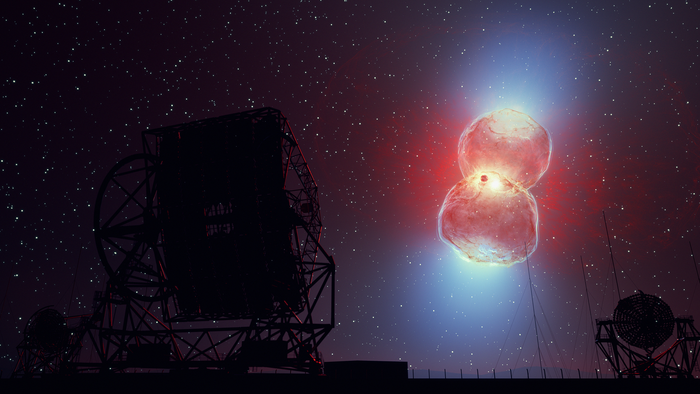Amateur astronomers help capture stellar explosion close to cosmic speed limit
Astronomers watching a stellar nova were surprised to find it accelerated gamma ray particles to the theoretical speed limits predicted by their models

Thanks to amateur astronomers, new technology, and a fast response by professional observers, researchers have witnessed a cosmic explosion pushing particles close to the cosmic speed limit for the first time.
In a new study published Thursday in the journal Science, an international team of researchers using the High Energy Stereoscopy System, or Hess, describe their observations of a massive explosion on the surface of a white dwarf star called a nova. They found the resulting shock wave accelerated gamma rays right to their theoretical speed limit in astrophysicists’ models, very near the speed of light.
It’s a finding that suggests the physical conditions around novae can approximate theoretical ideals, according to study author and doctoral candidate at Deutsches Elektronen-Synchrotron, Ruslan Konno, which he said has enormous implications for astrophysics.
“It suggests that the acceleration process could be just as efficient in their much more extreme relatives, supernovae,” he said in a statement.
It’s also possible novae could be a source of cosmic rays, the constant shower of high energy particles astronomers observe streaming at Earth from all directions in the sky. The exact origin of these rays is a topic of active research.
While a supernova takes place at the death of a giant star, a nova is a smaller explosion on the surface of a much smaller star, a white dwarf. And unlike a supernova, novae can take place without the destruction of the star, and can even repeat at regular intervals.
Novae occur when a white dwarf in a binary star system steals material from a larger companion star, usually a red dwarf. When enough stolen star stuff accretes on the surface of the white dwarf, it triggers a runaway fusion reaction — a thermonuclear explosion releasing 10,000 to 100,000 times the energy Earth’s Sun generates in a year in a matter of seconds.
The powerful nova explosion generates concentric, hourglass-shaped shockwaves that push out into space, compressing any expelled stellar material before them. This compressed material is energized, releasing and accelerating particles — the gamma rays that astronomers look for with instruments like Hess.
Mr Konno was one of more than 230 researchers from 41 different research organizations that used Hess to study the nova RS Ophiuchi when it exploded in August, 2021. RS Ophiuchi is a recurrent nova about 5,000 light years away and exploded in 2006 and 1985 before its most recent fireworks.
It was amateur astronomers that first alerted the Hess team that RS Ophiuchi had once again gone off, and the quick reaction of the Hess team — and a special new camera attached to a Hess telescope in Namibia — allowed the researchers to watch the nova bloom in real time. They measured gamma rays from the explosion for more than a month afterward, finding them to be hundreds of times more energetic than any seen in previous novae.
The Hess facility uses five gamma-ray sensitive telescopes that are part of the upcoming Cherenkov Telescope Array, a global network of telescopes designed to study gamma ray phenomena in the sky. A key objective for the Hess and the Cherenkov array will be to study other novae to see if they too display the powerful particle accelerating properties of RS Ophiuchi.
“Over the next few years, research using the [Cherenkov Telescope Array] telescopes will show whether this type of nova is special,” Hess director Stefan Wagner said in a statement. “This measurement is a further success in gamma-ray astronomy and an encouraging sign that we will be able to study many more cosmic explosions with H.E.S.S. and gamma-ray telescopes of the future.”
Join our commenting forum
Join thought-provoking conversations, follow other Independent readers and see their replies
0Comments